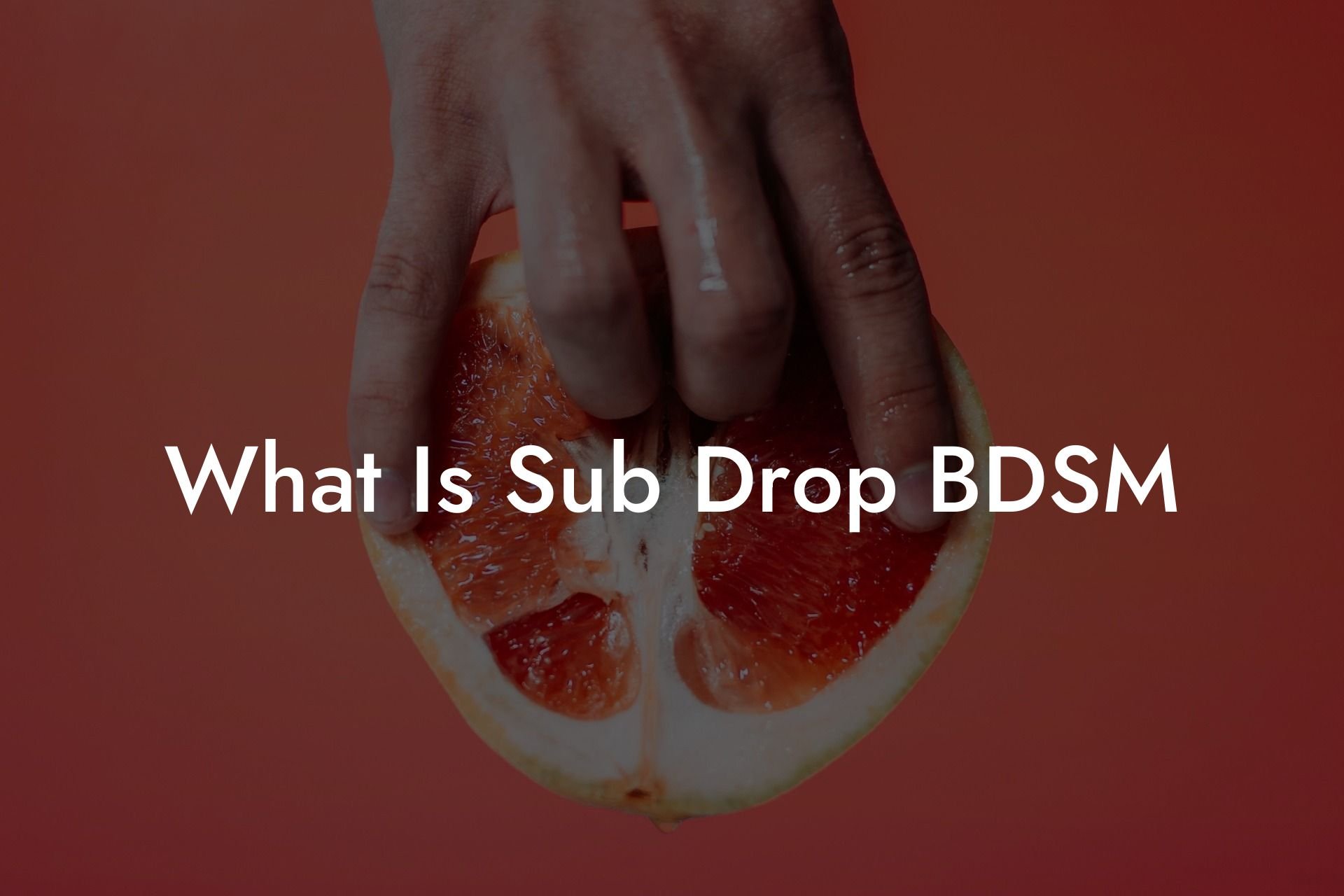What Is Sub Drop BDSM

Imagine riding an emotional roller coaster after a scene where you’ve given your all, only to suddenly feel drained, vulnerable, and even a bit lost. That’s what sub drop in BDSM can feel like, a profound, sometimes overwhelming crash following an intense exchange of power and passion. Whether you’re a submissive who’s experienced it firsthand or a Dominant concerned about your partner’s well-being, understanding sub drop is crucial. In this guide, we dive deep into what sub drop in BDSM means, its physical and emotional symptoms, the causes behind it, and practical strategies for prevention and recovery, all while emphasizing the importance of communication, aftercare, and self-compassion.
Quick Links to Useful Sections
- Understanding Sub Drop in BDSM
- What Is Sub Drop?
- Causes and Symptoms of Sub Drop
- Why Does Sub Drop Occur?
- Common Symptoms of Sub Drop
- Strategies for Managing Sub Drop
- Effective Aftercare Practices
- Self-Care Techniques for Submissives
- Tips for Dominants and Partners
- The Role of Communication in Mitigating Sub Drop
- Pre-Scene Negotiation
- Ongoing Check-Ins During the Scene
- Real-Life Experiences and Testimonials
- Case Study: Emma’s Journey Through Sub Drop
- Case Study: Ryan’s Supportive Approach
- Expert Insights and Guidance
- Words of Wisdom from the BDSM Community
- FAQ: Your “What Is Sub Drop in BDSM” Questions Answered
Understanding Sub Drop in BDSM
What Is Sub Drop?
Sub drop is a phenomenon commonly experienced by submissives after an intense BDSM scene. It’s characterized by a sudden emotional and sometimes physical downturn, a “drop” in mood, that can leave the submissive feeling drained, sad, or disoriented. While it might sound alarming, sub drop is a natural response to the intense exchange of energy that occurs during a scene. Essentially, it is the body’s way of rebalancing after the rush of adrenaline, endorphins, and intense emotions that BDSM play can trigger.
The experience of sub drop varies widely. For some, it might be a brief moment of melancholy that quickly passes with proper aftercare; for others, it can linger for hours or even days, affecting mood, energy levels, and overall well-being. Understanding that sub drop is a normal part of the BDSM journey can be incredibly reassuring, as it reinforces the importance of aftercare and self-compassion.
Causes and Symptoms of Sub Drop
Why Does Sub Drop Occur?
Sub drop is primarily caused by the intense physiological and emotional release that occurs during a BDSM scene. When a submissive gives up control, the body produces a flood of adrenaline and endorphins, natural chemicals that create feelings of euphoria, pain relief, and heightened pleasure. However, once the scene ends, these chemicals rapidly drop, leading to a temporary “crash” similar to what happens after a high-energy workout or an adrenaline rush.
Additionally, the deep emotional vulnerability experienced during a scene can take a toll once the intensity subsides. The contrast between the heightened state during play and the return to normalcy can leave some feeling empty or disconnected.
Common Symptoms of Sub Drop
Recognizing sub drop is the first step in managing it effectively. Common signs include:
- Emotional Low: Feelings of sadness, depression, or emotional numbness.
- Fatigue: A noticeable drop in energy levels, making even simple tasks feel overwhelming.
- Anxiety: Sudden bouts of anxiety or nervousness that can be triggered by the contrast in emotional states.
- Disorientation: A feeling of confusion or being “out of it,” as the mind and body readjust.
- Loss of Interest: A temporary disinterest in activities that are usually enjoyable, including aspects of daily life.
- Physical Sensations: Muscle soreness, headaches, or a general sense of physical discomfort may also be present.
Strategies for Managing Sub Drop
Effective Aftercare Practices
Aftercare is the cornerstone of managing sub drop. It involves taking intentional steps immediately after a scene to help your body and mind transition back to a normal state. Here are some essential aftercare practices:
- Hydration and Nutrition: Drink plenty of water or electrolyte-rich beverages. A light snack can also help restore energy levels.
- Physical Comfort: Use warm blankets, heating pads, or a gentle massage to relax sore muscles and soothe physical tension.
- Emotional Reassurance: Engage in calm, supportive conversations with your partner. Affirmations like “I’m here for you” or “You did great” can help rebuild emotional stability.
- Quiet Time: Sometimes, a period of solitude or low-stimulation can be beneficial. Consider dimming the lights, playing soft music, or simply resting in a comfortable, private space.
- Reflection and Journaling: Writing down your thoughts and feelings can help process the experience and provide insight into your emotional state.
Self-Care Techniques for Submissives
In addition to partner-provided aftercare, practicing self-care is vital to managing sub drop. Consider incorporating the following techniques:
- Meditation: Guided meditation or deep-breathing exercises can help calm your mind and regulate emotions.
- Light Exercise: Gentle activities like stretching or a short walk can boost endorphin levels and improve mood.
- Creative Outlets: Express yourself through art, music, or writing to process your feelings and reclaim your energy.
- Mindfulness: Practice mindfulness techniques to stay present and acknowledge your feelings without judgment.
Tips for Dominants and Partners
If you’re a Dominant or a partner in a BDSM scene, your role in helping manage sub drop is equally important. Consider these strategies:
Looking for the best BDSM & Kink OnlyFans content creators? Check out these UNBELIEVABLE OnlyFans Creators:
-
-
-
- Best Slutty Asian Cosplay OnlyFans → 🥵 Shadow Kitsune → View Pictures & Videos
- Best Solo & Dildo Play OnlyFans Creator → 🌹 Lexy , Your Fifty Shades of Fantasy 🌹 → View Pictures & Videos
- Best Filthy Teen Brat & Girlfriend Experience OnlyFans Creator → 💋 Alexa – Your Shy & Wild Girlfriend 💋 → View Pictures & Videos
- Best Slutty Submissive British Blonde OnlyFans Creator → Sofia 🧚 → View Pictures & Videos
- Best Anal, Sexting & Dick Rating OnlyFans Creator → Sofia💕 → View Pictures & Videos
- Best Hot Asian & Latina Mixed OnlyFans Creator → 🍑 Miso Lexii - Half Latina / Half Asian 👅 → View Pictures & Videos
-
-
- Initiate Aftercare: Be proactive about starting aftercare as soon as the scene ends. Your attention and care can make a huge difference in your partner’s recovery.
- Monitor Physical and Emotional Cues: Keep an eye out for signs of sub drop, and ask open-ended questions like “How are you feeling?” or “Is there anything you need right now?”
- Offer Reassurance: Validate their feelings and remind them that sub drop is a normal response to intense play. Your supportive presence is key.
- Plan for Extended Aftercare: Understand that sub drop might not resolve immediately. Follow up with your partner later to ensure they continue to feel supported and cared for.
The Role of Communication in Mitigating Sub Drop
Pre-Scene Negotiation
Open and honest negotiation before a scene is crucial in setting the stage for a positive experience. Discuss your potential aftercare needs and agree on what will be done to support recovery afterward. This might include specific requests like “I need a quiet space to decompress” or “I prefer to be held for at least 15 minutes after the scene.” Setting these expectations in advance not only prepares you for sub drop but also empowers you to communicate your vulnerabilities effectively.
Ongoing Check-Ins During the Scene
While sub drop typically occurs after the scene, regular check-ins during play can help minimize its intensity. Encourage your partner to signal if they begin feeling overwhelmed. Even a simple nod or a quick word can prompt an adjustment in the intensity or pace of the scene. This ongoing dialogue is vital in ensuring that the experience remains safe and pleasurable.
Real-Life Experiences and Testimonials
Case Study: Emma’s Journey Through Sub Drop
Emma, a seasoned submissive, recounts how sub drop used to leave her feeling isolated and drained after intense scenes. Over time, she learned to recognize the early signs of sub drop and communicated her needs more openly with her Dominant. With a tailored aftercare routine involving hydration, soothing touch, and time for reflection, Emma was able to turn her post-scene lows into opportunities for self-discovery and healing. Her experience highlights that sub drop, while challenging, can be managed effectively with the right strategies.
Emma’s story is a testament to the power of aftercare and open communication, proving that even the most intense emotional drops can be softened with proper care.
Case Study: Ryan’s Supportive Approach
Ryan, a devoted Dominant, shares how he adapted his aftercare practices after noticing signs of sub drop in his submissive partner. By initiating gentle check-ins immediately after the scene, offering a warm embrace, and maintaining an ongoing dialogue, Ryan was able to help his partner navigate the emotional downturn. Their shared commitment to aftercare not only mitigated the effects of sub drop but also deepened their mutual trust and intimacy.
Ryan’s approach serves as an inspiring example for Dominants on how to support their partners through the challenging moments that follow an intense scene.
Expert Insights and Guidance
Words of Wisdom from the BDSM Community
Veteran Dominant Marcus Steele advises, “Sub drop is a natural part of the intense energy exchange in BDSM play. The key is not to fear it but to prepare for it with thoughtful aftercare and open communication. Your willingness to support and care for your partner after a scene can transform sub drop into a healing experience.”
BDSM counselor Fiona Rivera adds, “Understanding and managing sub drop is essential for the well-being of all participants. With proper negotiation, safety protocols, and dedicated aftercare, the emotional lows can be mitigated, turning vulnerability into a source of strength and growth.”
FAQ: Your “What Is Sub Drop in BDSM” Questions Answered
1. What is sub drop in BDSM?
Sub drop is the emotional and physical low that some submissives experience after an intense BDSM scene, marked by feelings of fatigue, sadness, or disorientation.
2. Why does sub drop occur?
Sub drop typically occurs due to a sudden drop in adrenaline and endorphins after an intense scene, combined with the emotional vulnerability experienced during play.
3. What are the common symptoms of sub drop?
Symptoms can include feelings of depression or sadness, fatigue, disorientation, anxiety, and sometimes physical discomfort such as muscle soreness.
4. How can I recognize sub drop?
Recognize sub drop by noticing a significant shift in mood and energy levels after a scene. Signs may include tearfulness, withdrawal, or a marked decrease in enthusiasm for activities you normally enjoy.
5. What role does aftercare play in preventing sub drop?
Aftercare is crucial; it helps ease the transition from the heightened state of play to everyday life, providing both physical comfort and emotional support that can reduce the intensity of sub drop.
6. What are some effective aftercare practices for sub drop?
Effective aftercare practices include hydration, warm blankets, gentle massages, emotional debriefing, and quiet time for reflection. Tailor these practices to your individual needs.
7. Can sub drop be prevented entirely?
While sub drop may not be entirely preventable, its impact can be significantly reduced through thorough negotiation, continuous communication, and comprehensive aftercare.
8. What should Dominants do to help a partner experiencing sub drop?
Dominants should offer immediate reassurance, check in regularly, adjust the intensity of play if needed, and ensure that proper aftercare is provided, including both physical comfort and emotional support.
Looking for the best BDSM & Kink OnlyFans content creators? Check out these UNBELIEVABLE OnlyFans Creators:
-
-
-
- Best Slutty Asian Cosplay OnlyFans → 🥵 Shadow Kitsune → View Pictures & Videos
- Best Solo & Dildo Play OnlyFans Creator → 🌹 Lexy , Your Fifty Shades of Fantasy 🌹 → View Pictures & Videos
- Best Filthy Teen Brat & Girlfriend Experience OnlyFans Creator → 💋 Alexa – Your Shy & Wild Girlfriend 💋 → View Pictures & Videos
- Best Slutty Submissive British Blonde OnlyFans Creator → Sofia 🧚 → View Pictures & Videos
- Best Anal, Sexting & Dick Rating OnlyFans Creator → Sofia💕 → View Pictures & Videos
- Best Hot Asian & Latina Mixed OnlyFans Creator → 🍑 Miso Lexii - Half Latina / Half Asian 👅 → View Pictures & Videos
-
-
9. Are there self-care techniques to manage sub drop?
Yes, self-care techniques such as meditation, journaling, light exercise, and engaging in creative outlets can help manage the emotional and physical symptoms of sub drop.
10. Where can I learn more about managing sub drop?
You can learn more from resources like "SM 101: A Realistic Introduction," online communities such as FetLife and Reddit’s r/BDSM, podcasts like "Kink Academy," and workshops or seminars that focus on aftercare and emotional well-being in BDSM.
Resources and Community Support: Your Next Steps in Exploring Sub Drop in BDSM
- FetLife: Connect with communities to share aftercare tips and learn how others manage sub drop effectively.
- Reddit: Join subreddits like r/BDSM to read firsthand experiences and gather advice on self-care and aftercare practices.
- BDSM Literature: Explore books such as "SM 101: A Realistic Introduction" for comprehensive guidance on safe, consensual BDSM play and aftercare.
- Podcasts and Videos: Listen to "Kink Academy" and watch tutorials for expert insights on managing sub drop and developing effective aftercare routines.
- Workshops and Seminars: Attend local events to deepen your knowledge and build supportive connections with experienced practitioners.
Sub drop is a natural response to the intense exchange of energy during a BDSM scene. With thoughtful aftercare, open communication, and personalized self-care, you can transform these challenging moments into opportunities for healing, growth, and deeper connection.
Looking for the best BDSM & Kink OnlyFans content creators? Check out these UNBELIEVABLE OnlyFans Creators:
-
-
-
- Best Slutty Asian Cosplay OnlyFans → 🥵 Shadow Kitsune → View Pictures & Videos
- Best Solo & Dildo Play OnlyFans Creator → 🌹 Lexy , Your Fifty Shades of Fantasy 🌹 → View Pictures & Videos
- Best Filthy Teen Brat & Girlfriend Experience OnlyFans Creator → 💋 Alexa – Your Shy & Wild Girlfriend 💋 → View Pictures & Videos
- Best Slutty Submissive British Blonde OnlyFans Creator → Sofia 🧚 → View Pictures & Videos
- Best Anal, Sexting & Dick Rating OnlyFans Creator → Sofia💕 → View Pictures & Videos
- Best Hot Asian & Latina Mixed OnlyFans Creator → 🍑 Miso Lexii - Half Latina / Half Asian 👅 → View Pictures & Videos
-
-

 Fuck Each Other Not The Planet Unisex
Fuck Each Other Not The Planet Unisex Wear My Kink
Wear My Kink